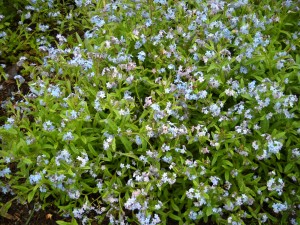Spring Forth Into Spring
This is a busy time for all of us in the garden. Not only are weeds up, some of them are already blooming. I try real hard to keep weeds from spreading their seeds in my garden beds, so I am doing my best to pull them now before they bloom and make seeds. And there is so much else to do I’m not sure if I have time to write this column!
Apple and crabapple trees are blooming everywhere, which draws my eyes to them. I can’t help but notice that so many need a little late pruning. What I keep seeing are root sprouts coming up alongside the trunk of these lovely trees, which is a distraction. And it only takes 5 minutes with a pair of loppers or a hand saw to remove those shoots.
While you’re at it, you may wish to take off any little branches that are sprouting from the main trunk below the first scaffold branches (those larger branches that reach out and up, and that have all those blossoms on them). A nice clean trunk is much better than one cluttered with unwanted sprouts.
Then there is the vegetable garden. I know we will still have frost here in Cornish Flat, so all those tomatoes and peppers and squash that I have started by seed inside need to stay in their pots. What I can do now, however, is” harden off” those seedlings. Hardening off is the process of getting seedlings ready for life outdoors.
Each nice day I should (but don’t always) carry all 12 trays of seedlings outdoors so my plants can work on their tan. That’s right, seedlings are like us – they need to start with just a little sunshine and breeze each day. Two hours of morning sun is good for a start, then 4 hours, then 2 hours of afternoon sun, and so on, increasing exposure until their leaves won’t burn or dry out even if they’re in the sun all day. If you buy seedlings it’s good to give them time to get used to the outdoors, too. Greenhouses do shelter seedlings considerably.
Right now I have thousands of forget-me-nots (Myosotis sylvatica) blooming everywhere: in garden beds, in the lawn, in the vegetable garden – even on the banks of my little stream (they love water). If you don’t have this fabulous, exuberant flower, you should. I wish I could give every reader a clump, but I bet one of your neighbors will share some with you, as most everyone has it. I rarely see them for sale at nurseries, but a few of the better ones do. Many flower books say they are biennials, but I’m not sure that’s true. Biennials only bloom in their second year, and then die. I have so many, it’s hard to know if they are re-seeding or coming back from their roots. So they may be perennials.
While weeding a patch of daffodils recently, I decided to take advantage of the fact that I had thoroughly loosened the soil surface. I spread my favorite organic fertilizer, Pro-Gro over the soil surface and scratched it in with my favorite weeder, the CobraHead. I had notice that those daffies were not flowering as previous years and decided to give the soil some extra nutrition and get rid of the weeds that were competing with them. Next spring I should have better blossoms.
Some gardeners like to divide big clumps of daffodils, though I generally don’t get around to it. The problem is that by fall I don’t know where those big clumps that need dividing are. The solution? Make some markers now and stick them in the soil. That works for marking places that need more bulbs, too.
It’s past time to rake off that leaf mulch or straw if you covered your vegetable garden with mulch last fall. I just raked mulch off my beds and into the walkways last week. By exposing the soil to the sun I do 2 things: I let the soil warm up and dry out more quickly, and I encourage weed seeds to germinate. I want the weeds to germinate before I plant so that I can hoe them over or pull them out, killing them before I plant. I also have a flame weeder which will burn off dozens of small annual weeds with a single, quick pass. (Available at Johnny’s Seeds or Fedco Seeds). But it does use propane, so is not as eco-friendly as hoeing.
Traditional gardeners grow their carrots, corn and cauliflower in narrow rows on flat ground. I don’t. I have mounded up beds that are 3 feet wide and 6 to 8 inches higher than the walkways. Wide beds produce more planting space in a garden when compared to those with narrow rows because there are fewer walkways. The wide, higher beds allow roots to spread wider and deeper than in traditional beds, and dogs and kids tend to stay out of them.
But if you have a sunny, warm weekend, don’t spend all day pulling weeds or working. Take time to sit and enjoy your flowers – and the butterflies, kids and dogs that love the garden, too.
Henry’s Web site is www.Gardening-Guy.com. It now has a search engine for finding any past columns you might have missed.




